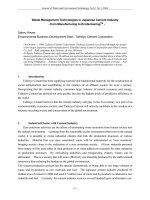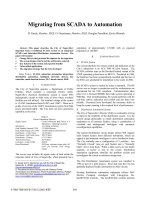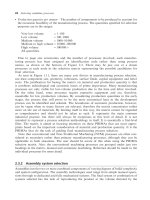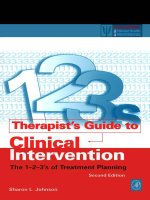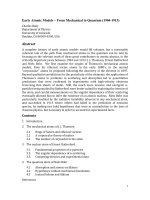Hereditary tumors, from genes to clinical consequences h allgayer, h rehder, s fulda (wiley, 2009)
Bạn đang xem bản rút gọn của tài liệu. Xem và tải ngay bản đầy đủ của tài liệu tại đây (3.78 MB, 562 trang )
Hereditary Tumors: From
Genes to Clinical
Consequences
Edited by
Heike Allgayer
Helga Rehder
Simone Fulda
WILEY-VCH
Hereditary Tumors
Edited by
Heike Allgayer, Helga Rehder
and Simone Fulda
Related Titles
R. A. Meyers (Ed.)
M. S. A. Tuffaha
Cancer
Phenotypic and Genotypic
Diagnosis of Malignancies
From Mechanisms to Therapeutic
Approaches
2007
ISBN: 978-3-527-31768-4
An Immunohistochemical and
Molecular Approach
2008
ISBN: 978-3-527-31881-0
K.-M., Debatin, S. Fulda (Eds.)
Apoptosis and Cancer
Therapy
From Cutting-edge Science to Novel
Therapeutic Concepts
2006
ISBN: 978-3-527-31237-5
C. S. S. R. Kumar (Ed.)
Nanomaterials for Cancer
Diagnosis
2007
ISBN: 978-3-527-31387-7
C. S. S. R. Kumar (Ed.)
H. zur Hausen
Infections Causing Human
Cancer
2006
ISBN: 978-3-527-31056-2
Nanomaterials for Cancer
Therapy
2006
ISBN: 978-3-527-31386-0
Hereditary Tumors
From Genes to Clinical Consequences
Edited by
Heike Allgayer, Helga Rehder,
and Simone Fulda
The Editors
Prof. Dr. Heike Allgayer, PhD
University of Heidelberg
and DKFZ (German Cancer Research Center)
Heidelberg
Medical Faculty Mannheim
Theodor-Kutzer-Ufer 1–3
68167 Mannheim
Germany
Prof. Dr. Helga Rehder
Medical University Vienna
Department of Medical Genetics
Währinger Strasse 10
1090 Wien
Austria
Prof. Dr. Simone Fulda
Ulm University Children’s Hospital
Eythstrasse 24
89075 Ulm
Germany
All books published by Wiley-VCH are carefully
produced. Nevertheless, authors, editors, and
publisher do not warrant the information
contained in these books, including this book,
to be free of errors. Readers are advised to keep
in mind that statements, data, illustrations,
procedural details or other items may
inadvertently be inaccurate.
Library of Congress Card No.: applied for
British Library Cataloguing-in-Publication Data
A catalogue record for this book is available from
the British Library.
Bibliographic information published by the
Deutsche Nationalbibliothek
The Deutsche Nationalbibliothek lists this
publication in the Deutsche Nationalbibliografie;
detailed bibliographic data are available on the
Internet at .
© 2009 WILEY-VCH Verlag GmbH & Co. KGaA,
Weinheim
All rights reserved (including those of translation
into other languages). No part of this book may
be reproduced in any form – by photoprinting,
microfilm, or any other means – nor transmitted
or translated into a machine language without
written permission from the publishers.
Registered names, trademarks, etc. used in this
book, even when not specifically marked as such,
are not to be considered unprotected by law.
Typesetting SNP Best-set Typesetter Ltd.,
Hong Kong
Printing Strauss GmbH, Mörlenbach
Binding Litges & Dopf GmbH, Heppenheim
Printed in the Federal Republic of Germany
Printed on acid-free paper
ISBN:
978-3-527-32028-8
V
Foreword
This book will be published in the fourteenth year of the IzS Foundation – a great
pleasure for me!
The beginnings of the Foundation in the early 1990s were really not that easy.
One group of people maintained that if women are to be supported, then they
should be the unemployed, the sick, or mothers with children. If those to be supported must be academic women, then at least they should be the ones with
problems, for whatever reason. Another group asserted that an award can only be
given to someone dedicated to gender equality, women’s rights, or similar
issues.
In my opinion, support is already available for the aforementioned groups –
perhaps not enough, but, after all, there is a large social network. Officials charged
with ensuring women’s rights are certainly necessary to implement existing laws
but, I think, they are not essential. Hopefully, the need for these officials will soon
disappear – because who among us wants to be a “token woman”?
What is really important is to permit women to employ their intellectual potential positively, so that they receive encouragement and support on their often
VI
Foreword
thorny path – support in terms of saying “you are great, don’t be deterred, and stay
on your course!”.
I would like to repeat three statements I once gave as the Founder of the IzS
Foundation:
•
•
•
We support the intellectual elite of women, so that they do stay at their work and
don’t go back to the kitchen for ever.
A person who supports the intellectual elite also supports others – indirectly, but
perhaps more efficiently.
We support the status of women not via a bottom-up approach, but by raising
standards.
These are the reasons why the IzS scientific awards were created. They certainly
are a financial stimulus, but it is much more important to publicly highlight these
excellent scientific women!
In order to achieve these aims and ensure their effective endurance, we stimulate an efficient, interdisciplinary network among the recipients. For this reason,
the IzS Foundation has initiated the IzS Fellowship to include all our award recipients, with the central aim that they support and coach one another.
This includes, but is not restricted to, informal regular e-mail and telephone
contacts, meetings on the occasion of the annual award ceremony organized by
the Foundation Board, and additional seminars about important career issues. For
example, the last Fellowship seminar was held on “Contact with the Media.”
At present, the members of the Fellowship are ten recipients of the Medical
Research Award, two co-opted members, and two honorary members. The ten
Award recipients are Babette Simon (Full Professor and Vice President, Marburg
University, Germany), Barbara Rehermann (Full Professor, NIH, Frederick, USA),
Rita Schmutzler (Full Professor, University of Cologne, Germany), Claudia Frank
(Associate Professor, now in own practice), Simone Fulda (Full Professor, University of Ulm, Germany), Heike Allgayer (Full Professor, University and German
Cancer Research Center Heidelberg, Germany), Carola Berking (Associate Professor, Ludwig Maximilians University Munich, Germany), Silke Anders (Medical
Research Associate and Guest Scientist, University of Luebeck and Bernstein
Center for Computational Neuroscience, Berlin, Germany), Rohini Kuner (Full
Professor, University of Heidelberg, Germany), and Henriette Löffler-Stastka (Full
Professor, University of Vienna, Austria). Further members of the Fellowship are
Isabel Mundry (composer, Full Professor), Shi-Yeon Sung (musical conductor),
Natalie Clein, Kaori Yamagami, and Eun Sung Hong (cellists), as the winners of
the Music/Culture Award. With increasing interactions between all Fellows, we
find striking similarities in career mechanisms and obstacles. In 2008, Dr Rafaela
Hillerbrand (University of Oxford, UK) also joined the Fellowship as the first basic
scientist to win the new IzS Basic Research and Informatics Award.
Foreword
Two awards for promoting human rights have been given:
•
•
In 2002 to “Forward Germany” e.V., working against female gender mutilation
in Germany,
In 2007 to Seyran Ates, German–Turkish lawyer, living in Berlin, for her work
to improve the situation of Muslim women in Germany.
We are on the way!
I congratulate the IzS Fellows who created this book on the increasingly important topic of Hereditary Tumors, collaborating with a significant majority of female
authors as experts in the respective fields – but certainly equally acknowledging the
expertise of their male colleagues and authors. I thank all of them sincerely, above
all Heike Allgayer for this outstanding work!
Let us go forward together to improve the status of women!
Dr med. Ingrid Gräfin zu Solms-Wildenfels
Founder and Donor, the Ingrid zu Solms-(IzS)-Foundation
A foundation dedicated to the support of the female intellectual
elite in science, culture, and to ensuring human rights
Frankfurt, Germany, January 14, 2008
VII
IX
Preface
Due to recent rapid advances in genomics, there has been an enormous progress
over the last years in our understanding of hereditary and familial tumors and
cancer syndromes. It is now well appreciated that hereditary conditions, such as
germline mutations or polymorphisms, may have an important impact on tumorigenesis and tumor progression in humans. Also, the genetic composition may
substantially impinge on the individual response to cancer therapy. However, we
were surprised to learn that no comprehensive book so far compiles these tremendous achievements into an overall and state-of the art picture of hereditary and
familial tumors. In response to this demand, the objective of this book is to give
the latest and updated overview on the existing knowledge on hereditary aspects
of human cancers, to elucidate their molecular mechanisms, to discuss the
diagnostic potential of genetic changes, and to summarize cutting-edge developments in disease management and treatment of hereditary tumors and cancer
syndromes.
The structure of the book provides a first general section outlining essential
mechanisms relevant for tumorigenesis, progression and metastasis, and specific
molecular events contributing to hereditary tumor diseases. In a second section,
overviews on the syndromal types of hereditary tumors are given, followed by a
specific section in which hereditary tumor conditions are discussed for specific
organs and sites. Finally, a last section provides general thoughts, trends and
examples for genetic counseling, psycho-oncology, and molecular targeted therapy.
By providing a framework on how our knowledge on genetic causes of hereditary
tumors can be translated into clinical application, we believe that the book will be
of interest to a broad readership, including geneticists, oncologists, pathologists,
molecular and cell biologists, and those working in pharmaceutical and biotechnological industries.
Frankfurt/Main, Mannheim/Heidelberg,
Ulm, Vienna, October 2008
Heike Allgayer, Simone Fulda,
Helga Rehder, and the Fellowship
of the Ingrid zu Solms-Foundation
XI
Contents
Foreword
Preface
V
IX
List of Contributors
XXV
Part I
Hereditary Tumors – General Aspects
1
General Insights Into Tumor Invasion, Progression, and
Metastasis 3
Heike Allgayer
Summary 3
The Metastatic Cascade 3
Key Molecules Promoting Metastasis 7
Adhesion and Migration 7
Tumor-Associated Proteolysis and Invasion 8
u-PA 8
u-PAR 10
Plasminogen Activator Inhibitors 10
Evidence for Diverse Functions of the u-PAR System Relevant for
Cancers 10
Factors for Tumor Growth and Angiogenesis 13
Potential Hereditary Aspects of Molecules Promoting Metastasis 16
References 17
1.1
1.2
1.2.1
1.2.2
1.2.2.1
1.2.2.2
1.2.2.3
1.2.2.4
1.2.3
1.3
2
2.1
2.2
2.2.1
2.2.2
2.3
2.3.1
The Genetic Background of Hereditary Tumor Diseases 25
Ortrud K. Steinlein
Summary 25
Introduction 25
Sporadic Versus Hereditary Tumors 27
Sporadic Malignancies Are More Common 27
Red Flags for Hereditary Tumors 28
Inheritance Patterns in Hereditary Tumor Predispositions 29
Autosomal Dominant Inheritance 29
XII
Contents
2.3.2
2.4
2.4.1
2.5
2.5.1
2.5.2
2.6
2.6.1
2.6.2
2.6.3
2.7
Autosomal Recessive Inheritance 30
Genotype–Phenotype Relations in Hereditary Tumor
Predispositions 30
Mechanisms Underlying Genotype–Phenotype Relations 31
From Predisposition to Cancer – Is One Gene Enough? 32
Experimental Evidence for the Two-Hit Hypothesis 32
“Multi Hit” and Recruitment Hypotheses 33
The Phenomena of Cell-Type Specificity 34
Colocalization of Additional Mechanisms 34
The Involvement of More Than One Cell Type 35
Cell-Type Specificity in Recessive Inheritance 36
Conclusions and Future Directions 36
References 36
Part II
Syndromal Types of Hereditary Tumors
3
Family Cancer Syndromes 43
Helga Rehder
Summary 43
Introduction 43
Hereditary Non-Polyposis Colon Cancer Syndromes (HNPCC) 60
APC-Associated Polyposis Syndromes 62
Hamartomatous Tumor Syndromes 63
Familial Endocrine Tumor Syndromes 65
Familial Cancer Associated Genodermatoses 68
Familial Renal Cancer Syndromes 73
Sarcoma Family Syndrome 76
References 77
3.1
3.2
3.3
3.4
3.5
3.6
3.7
3.8
4
4.1
4.1.1
4.1.2
4.1.3
4.1.4
4.1.5
4.1.6
4.1.7
4.2
4.2.1
4.2.2
Genetic Dysmorphic Syndromes Leading to Tumorigenesis 87
Gabriele Gillessen-Kaesbach
Summary 87
Overgrowth Syndromes 87
Beckwith–Wiedemann Syndrome (BWS) 88
Isolated Hemihyperplasia (IHH) 89
Proteus Syndrome (PS) 90
Sotos Syndrome (SS) 90
Weaver Syndrome (WS) 91
Simpson–Golabi–Behmel Syndrome (SGBS) 91
Bannayan–Riley–Ruvalcaba Syndrome (BRRS) 92
Syndromes with Mutations in the Mitogen-Activated Protein
Kinase (MAPK)-RAS Pathway 92
Noonan Syndrome (NS) 92
Cardio-Facio-Cutaneous Syndrome (CFC) 93
Contents
4.2.3
4.2.4
4.3
4.3.1
4.3.2
4.3.3
Costello Syndrome (CS) 94
Noonan-Neurofibromatosis Syndrome (NFNS) 94
Miscellaneous Dysmorphic Syndromes Leading to Tumorigenesis 95
Gorlin Syndrome (Nevoid Basal Cell Carcinoma Syndrome,
NBCCS) 95
Rubinstein-Taybi Syndrome (RSTS) 97
Rothmund–Thomson Syndrome (RTS) 97
References 98
Part III Site-Specific Aspects of Hereditary Tumors
5
5.1
5.2
5.3
5.4
5.5
5.6
5.7
5.8
5.9
5.10
6
6.1
6.1.1
6.1.2
6.1.3
6.2
6.2.1
6.2.2
6.2.3
6.3
6.4
6.4.1
6.4.2
6.5
Hereditary Brain Tumors 109
Christine Marosi
Summary 109
Introduction and General Concepts 109
Cowden Syndrome 110
Li–Fraumeni Syndrome 112
Naevoid Basal Cell Carcinoma Syndrome (NBCCS)
Neurofibromatosis I 113
Neurofibromatosis Type 2 114
Rhabdoid Tumour Predisposition Syndrome 116
Tuberous Sclerosis (TSC) 117
Turcot Syndrome 118
von Hippel–Lindau syndrome 120
References 121
112
Neurofibromatosis 127
Katharina Wimmer, Hildegard Kehrer-Sawatzki, and Eric Legius
Summary 127
Clinical Diagnosis 127
Neurofibromatosis Type 1 127
Neurofibromatosis Type 2 130
Schwannomatosis 130
The Disease-Causing Genes 131
The NF1 Gene and Its Gene Product Neurofibromin 131
The NF2 Gene and Its Gene Product Merlin 132
INI1: The Familial Schwannomatosis Gene? 133
Genetic Testing 133
Clinical Manifestations 135
Tumors Arising in NF1 Patients 135
Tumors Arising in NF2 Patients 137
Future Perspective/Translational Medicine 138
References 139
XIII
XIV
Contents
7
7.1
7.2
7.3
7.4
7.5
7.5.1
7.5.1.1
7.5.1.2
7.5.1.3
7.5.2
7.5.2.1
7.5.2.2
7.5.2.3
7.5.2.4
7.5.2.5
7.5.2.6
7.6
8
8.1
8.2
8.2.1
8.3
8.3.1
8.3.2
8.3.3
8.3.4
8.4
9
9.1
Retinoblastoma: The Prototypic Hereditary Tumor 147
Helen Dimaras and Brenda L. Gallie
Summary 147
Introduction 147
Clinical Features 148
Clinical Retinoma 150
Nature of Susceptible Retinal Cell 151
Progression from Normal Retina to Retinoblastoma 151
Tumor Initiation: Bi-Allelic Inactivation of RB1 151
Types of RB1 Mutations 152
Penetrance and Expressivity of RB1 Mutations 152
RB1 Loss and Retinoma 153
Tumor Progression: Post-RB1 Genomic Changes in
Retinoblastoma 154
Genomic Gain at Chromosome 1q 155
Genomic Gain of 2p: NMYC 155
Genomic Gain at Chromosome 6p 155
Genomic Loss at Chromosome 16q 156
Cell Death Regulator p53 156
NGFR/p75NTR 156
Conclusions 157
References 157
Hereditary Cancer in the Head and Neck 163
Barbara Wollenberg
Summary 163
Familial Factors in Head and Neck Squamous Cell Cancer
(HNSCC) 163
Interactions of Genetic and Environmental Factors 164
Metabolizing Enzyme Polymorphism 164
Mutagenicity, Genetic Susceptibility and Tumor Suppressor
Genes 165
Mutagenicity in Bleomycin Assays 165
Multiple Primary Cancers 165
Relationship between the Genetic Susceptibility to HNSCC and the
Presence of Common Fragile Sites 165
Germline Mutations of Tumor Suppressor Gene p16INK4a (p16) 166
Familial Nasopharyngeal Carcinoma 166
References 167
Hereditary Medullary and Familial Non-Medullary Thyroid
Carcinoma 169
Theresia Weber
Summary 169
Introduction 169
Contents
9.2
9.2.1
9.2.2
9.2.3
9.2.4
9.3
10
10.1
10.2
10.3
10.3.1
10.3.2
10.3.3
10.4
10.5
10.6
10.7
11
11.1
11.2
11.2.1
11.2.1.1
11.2.1.2
11.2.2
11.2.2.1
11.2.2.2
11.2.2.3
11.2.3
11.3
11.4
11.5
11.5.1
11.5.2
11.5.3
11.5.4
Hereditary Medullary Thyroid Carcinoma 170
Genetic Testing for MEN 2A, MEN 2B and FMTC 171
Genotype-Phenotype-Correlation 172
Surgical Management for Hereditary MTC 172
Postoperative Management and Prognosis of Medullary Thyroid
Carcinoma 175
Familial Nonmedullary Thyroid Carcinoma 176
References 177
Lung Tumors 183
Sarah Danson, M Dawn Teare, and Penella Woll
Summary 183
Introduction 183
Familial Aggregation Studies of Lung Cancer 184
Polymorphisms 185
Detoxification Genes 185
DNA Repair Genes 187
Others 188
Genome Wide Association Studies 188
Other Thoracic Tumors 189
Future Directions 189
Conclusions 189
References 190
Hereditary Breast Cancer 193
Rita Katharina Schmutzler
Summary 193
Introduction 193
Genetic Background 194
High Penetrance Genes 194
BRCA1 194
BRCA2 195
Low Penetrance Genes 196
CHEK2 197
ATM 197
PALP2 197
Genome-Wide Association Studies 197
Risk Calculation 198
Clinical and Histopathological Characteristics 199
Clinical Management 199
Ovarectomy 200
Mastectomy 200
Prevention Using Drugs 200
Structured Surveillance 201
References 202
XV
XVI
Contents
12
Hereditary Ovarian and Endometrial Cancer 207
Marion Kiechle
Summary 207
12.1
Epidemiology 207
12.2
Genetic Background 208
12.3
Phenotype 210
12.4
Clinical Management 211
12.5
Prevention Strategies 212
12.5.1 Primary Prevention 212
12.5.1.1 Prophylactic Salpingo-Oophorectomy (BPSO) 212
12.5.1.2 Prevention Using Drugs 212
12.5.2 Secondary Prevention (Structured Surveillance) 213
References 213
13
13.1
13.2
13.3
13.3.1
13.3.2
13.4
13.5
13.6
14
14.1
14.2
14.3
14.4
14.5
14.5.1
14.5.2
14.5.3
14.5.4
14.6
14.6.1
14.6.2
14.6.3
Prostate Cancer 215
Raphaela Waidelich
Summary 215
Epidemiology 215
Phenotypes of Prostate Cancer 216
Genetics 216
Hereditary Transmission 216
PC Susceptibility Genes 217
Prevention and Early Detection 222
Therapy 222
Future Aspects 222
References 223
Wilms and Rhabdoid Tumors of the Kidney 231
Brigitte Royer-Pokora
Summary 231
Wilms Tumor 232
The WT1 Gene and Its Functions 234
Function of the WT1 Gene in the Development of the Kidneys
and the Formation of Tumors 235
Wilms Tumor-Associated Syndromes 235
WT1 Gene Associated Syndromes 236
Aniridia and WAGR Syndrome 236
Genitourinary Anomalies (GU) and Isolated Nephrotic
Syndrome (NS) 236
Denys–Drash Syndrome (DDS) 237
Frasier-Syndrome (FS) 237
Non-WT1 Gene Associated Syndromes 238
Overgrowth Syndromes 238
Familial Wilms Tumors 238
Tumor Predisposition Syndromes 239
Contents
14.6.4
14.7
14.8
Malignant Renal Rhabdoid Tumor (MRR) 239
Micro-Deletion Syndromes and Tumor Risk 241
Recommendations for Genetic Counseling and Therapy 241
References 242
15
Hereditary Renal Tumors of the Adult 245
Liesbeth Spruijt and Nicoline Hoogerbrugge
Summary 245
General Introduction 245
Renal Cell Carcinoma 246
Introduction 246
Familial Clear Cell RCC 246
Von Hippel–Lindau (VHL) Disease 246
Constitutional Chromosome 3 Translocations 247
Familial Clear Cell Renal Cell Cancer (FCRC) 248
SDHB-Associated Heritable Paraganglioma 248
Tuberous Sclerosis Complex (TSC) 248
Familial Papillary RCC 249
Hereditary Papillary RCC (HPRC) 249
Hereditary Leiomyomatosis Renal Cell Cancer (HLRCC) 249
Hyperparathyroidism–Jaw Tumor (HPT-JT) 250
Papillary Thyroid Carcinoma with Associated Renal Neoplasia
(FPTC-PRN) 250
Familial Chromophobe RCC and Oncocytomas 250
Birt–Hogg–Dubé syndrome (BHD) 250
Medullary Renal Carcinoma (MRC) 251
Transition Cell Cancers of the Renal Pelvis 251
Lynch Syndrome 251
Diagnostic Recommendations 252
Therapeutic Recommendations 253
References 254
15.1
15.2
15.2.1
15.2.2
15.2.2.1
15.2.2.2
15.2.2.3
15.2.2.4
15.2.2.5
15.2.3
15.2.3.1
15.2.3.2
15.2.3.3
15.2.3.4
15.2.4
15.2.4.1
15.2.5
15.3
15.3.1
15.3.2
15.3.3
16
16.1
16.2
16.2.1
16.2.1.1
16.2.1.2
16.2.1.3
16.2.1.4
16.2.1.5
16.2.2
16.2.2.1
Gastrointestinal Polyposis Syndromes 257
Waltraut Friedl and Stefanie Vogt
Summary 257
Introduction 258
Adenomatous Polyposis Syndromes 259
APC-Associated Familial Adenomatous Polyposis (FAP)
Classic (Typical) FAP 259
Attenuated FAP (AFAP, AAPC) 262
Allelic Subtypes of Classic FAP 262
Genetics 262
Clinical Management 265
MUTYH-Associated Polyposis (MAP) 269
Clinical Features 269
259
XVII
XVIII
Contents
16.2.2.2
16.2.2.3
16.3
16.3.1
16.3.1.1
16.3.1.2
16.3.1.3
16.3.1.4
16.3.2
16.3.2.1
16.3.2.2
16.3.2.3
16.3.2.4
16.3.3
16.3.3.1
16.3.3.2
16.3.3.3
Genetics 269
Clinical Management 269
Hamartomatous Polyposis Syndromes 270
Peutz–Jeghers Syndrome (PJS) 270
Clinical Diagnosis 270
Genetics 271
Tumor Risk 271
Clinical Management 272
Juvenile Polyposis Syndrome (JPS) 272
Clinical Diagnosis 272
Genetics 273
Tumor Risk 274
Clinical Management 274
PTEN Hamartoma Tumor Syndrome (PHTS) 274
Clinical Diagnosis 274
Genetics 275
Cancer Risk and Clinical Management 275
References 275
17
Lynch Syndrome (HNPCC) 281
Gabriela Möslein
Summary 281
Introduction 281
Characteristics of Lynch Syndrome 282
Genetic Alteration 284
Lynch Syndrome, HNPCC or Familial Cancer?
Clinical Identification 284
Surveillance Colorectum 286
Familial Cancer 287
Surveillance of the Endometrium/Ovary 287
Surveillance for Other Related Cancers 288
Surgical Management 288
Chemotherapy 289
References 290
17.1
17.2
17.3
17.4
17.5
17.6
17.7
17.8
17.9
17.10
17.11
18
18.1
18.1.1
18.1.2
18.1.3
18.1.4
18.2
18.2.1
284
Gastrointestinal Stromal Tumors (GISTs) 295
Maria Debiec-Rychter
Summary 295
Sporadic GISTs 296
Epidemiology and Clinicopathologic Features of GISTs 296
The KIT Gene 296
Pathogenesis and Molecular Features of GISTs 297
Imatinib Mesylate in the Treatment of Advanced GISTs 298
Hereditary GISTs 298
Familial GIST Syndrome 299
Contents
302
18.2.2
18.2.3
18.2.4
GISTs Associated with Neurofibromatosis Type I
Carney–Stratakis Syndrome 302
Carney Triad 303
References 304
19
Hereditary Gastric Cancer 309
Holger Vogelsang and Gisela Keller
Summary 309
Introduction to Gastric Cancer 310
Criteria of Potential Heredity 312
Hereditary Gastric Cancer 312
Hereditary Diffuse Type Gastric Cancer (HDGC) 313
Clinical Presentation 313
Molecular Genetics 315
Histology 318
Surveillance, Predictive Testing, and Therapy 318
HNPCC Associated Gastric Cancer 320
Clinical Presentation 320
Molecular Genetics 320
Histology 323
Surveillance, Predictive Testing and Therapy 324
Familial Gastric Cancer of Unknown Origin 324
Clinical Presentation 324
Molecular Genetics 325
Histology 328
Surveillance and Therapy 330
Gastric Cancer as Part of Rare Hereditary Tumor Syndromes 331
Impact of Polymorphisms on Gastric Cancer Risk 334
Future Perspectives 335
References 335
19.1
19.2
19.3
19.4
19.4.1
19.4.2
19.4.3
19.4.4
19.5
19.5.1
19.5.2
19.5.3
19.5.4
19.6
19.6.1
19.6.2
19.6.3
19.6.4
19.7
19.8
19.9
20
20.1
20.2
20.3
20.3.1
20.3.2
20.3.3
20.3.4
20.3.5
20.3.6
20.4
Pancreatic Cancer 345
Nils Habbe and Babette Simon
Summary 345
Introduction 345
History and Epidemiology of Familial Pancreatic Cancer 345
Inherited Tumor Syndromes Associated with Pancreatic Cancer 346
Familial Atypical Multiple Mole Melanoma 346
Peutz-Jeghers-Syndrome 347
Hereditary Breast and Ovarian Cancer 347
Hereditary Nonpolyposis Colon Cancer and Familial Adenomatous
Polyposis 347
Ataxia Telangiectasia 347
Pancreatic Cancer and Basal Cell Carcinoma 348
Hereditary Pancreatitis and Cystic Fibrosis 348
XIX
XX
Contents
20.5
20.5.1
20.5.2
20.6
Familial Pancreatic Cancer 348
Genetic Background of Familial Pancreatic Cancer 349
Current Status of Surveillance and Treatment in FPC 350
Conclusion 352
References 352
21
Liver Tumors 355
Sabine J. Presser
Summary 355
21.1
Introduction 355
21.2
Hereditary Diseases Affecting Liver Function and Carcinogenesis 356
21.2.1 Hemochromatosis 356
21.2.2 Wilson’s Disease 358
21.2.3 Alpha 1-Antitrypsin Deficiency 360
21.2.4 Cystic Fibrosis 362
21.2.5 Galactosemia 362
21.2.6 Fructosemia 363
21.2.7 Tyrosinemia 363
21.2.8 Glycogen Storage Disease 364
21.2.9 Beckwith–Wiedemann Syndrome 364
21.2.10 FAP (Familial Adenomatous Polyposis) 365
21.2.11 Alagille Syndrome 365
21.3
Liver Carcinogens 366
21.4
Cancer Genetics 366
References 368
22
22.1
22.2
22.3
22.4
22.5
22.6
22.7
22.8
22.9
22.10
22.11
22.12
DNA-Repair Deficiency and Cancer: Lessons from Lymphoma 377
Krystyna H. Chrzanowska, Martin Digweed, Karl Sperling, and
Eva Seemanova
Summary 377
Introduction 377
DNA Repair 378
Base Excision Repair (BER) 378
Nucleotide Excision Repair (NER) 379
Mismatch Repair (MMR) 379
Reversion Repair (RER) 380
Recombination Repair (RR) 381
Genetic Diseases with a High Risk of Lymphoma:
Ataxia-Telangiectasia and Nijmegen Breakage-Syndrome 382
Lymphoma in Ataxia-Telangiectasia and Nijmegen Breakage
Syndrome 384
Treatment of Malignancies in Nijmegen Breakage Syndrome 387
Somatic Mutations in Sporadic Lymphoma 388
Outlook and Perspectives 389
References 390
Contents
23
23.1
23.2
23.2.1
23.2.2
23.2.2.1
23.2.2.2
23.2.2.3
23.2.2.4
23.2.2.5
23.2.3
23.2.3.1
23.2.3.2
23.2.4
23.2.4.1
23.2.4.2
23.2.4.3
23.2.5
23.3
23.3.1
23.3.2
23.3.3
23.3.4
23.3.5
24
Familial Leukemias 393
Christa Fonatsch
Summary 393
Introduction 393
Leukemias Associated with Genetic Syndromes 394
DNA Repair Deficiency Syndromes 394
Bone Marrow Failure Syndromes 394
Fanconi’s Anemia 394
Dyskeratosis Congenita 396
Shwachman-Diamond Syndrome 396
Severe Congenital Neutropenia and Kostmann Syndrome 397
Diamond-Blackfan Anemia 397
Constitutional Chromosome Anomalies 398
Down’s Syndrome (Trisomy 21) 398
Trisomy 8 398
Hereditary Tumor Predisposition Syndromes 399
Li–Fraumeni Syndrome 399
Neurofibromatosis Type 1 400
Noonan Syndrome 400
Hemochromatosis 400
Hereditary Non-Syndromal Leukemia 401
Familial Thrombocytopenia with Leukemia Predisposition and
Mutation of the CBFA2/RUNX1/AML1 Gene 401
CEBPA Mutations and Familial AML 401
Familial Myelodysplasia of Childhood with Monosomy 7 402
Familial Chronic Lymphocytic Leukemia 402
Genetic Susceptibility Factors for CLL and Other Leukemias 404
References 405
Malignant Melanoma 411
Carola Berking and Anja Katrin Bosserhoff
Summary 411
24.1
Introduction 411
24.1.1 Epidemiology 411
24.1.1.1 High Penetrance Genes 412
24.1.1.2 Low Penetrance Genes 415
24.2
More Melanoma-Susceptibility Genes 417
24.3
Sporadic Melanoma 417
24.4
Conclusion 418
Abbreviations 418
References 419
XXI
XXII
Contents
25
25.1
25.1.1
25.1.2
25.1.3
25.1.4
25.1.5
25.1.6
25.1.7
25.2
25.2.1
25.2.2
25.2.3
25.2.4
25.2.5
26
26.1
26.2
26.3
26.4
26.5
26.6
26.7
27
27.1
27.1.1
27.1.2
27.1.3
27.2
27.2.1
Xeroderma Pigmentosum, Cockayne Syndrome, Trichothiodystrophy –
Defects in DNA Repair and Carcinogenesis 421
Steffen Emmert
Summary 421
The Nucleotide Excision Repair (NER) – Defective Syndromes 421
Xeroderma Pigmentosum (XP) 422
XP Plus Neurologic Abnormalities 425
Cockayne Syndrome (CS) 427
XP/CS Complex 428
Trichothiodystrophy (TTD) 428
XP/TTD Complex 430
COFS (Cerebro-Oculo-Facio-Skeletal Syndrome) 430
The Nucleotide Excision Repair (NER) Pathway 431
Damage Recognition (I) 431
Damage Demarcation (II) 432
Incision of the Damage Containing DNA Strand (III) 432
Removal of the Damage Containing Oligonucleotide (IV) 433
Gap Filling (V) 433
References 433
Hereditary Tumors in Children 441
Simone Fulda
Summary 441
Introduction 441
Familial Neoplastic Syndromes Associated with Childhood
Cancer 442
Non-Neoplastic Genetic Syndromes Associated with Childhood
Cancer 445
Numerical Chromosome Abnormalities Associated with Childhood
Cancer 446
Inherited Immune Deficiency Syndromes Associated with
Childhood Cancer 447
Inherited Bone Marrow Failure Syndromes Associated with
Childhood Cancer 448
Conclusions 448
References 449
Sarcomas and Bone Tumors in Adulthood 453
Eva Wardelmann
Summary 453
Epidemiology 453
Incidence of Soft Tissue and Bone Sarcomas in General 453
Mortality 454
Proportion of Hereditary Tumors 454
Syndromes 454
Prevention/Prediction 463
References 463
Contents
Part IV Genetic Counseling, Psycho-Oncology, and General Perspectives
for Therapeutic Strategies
28
Genetic Counseling for Hereditary Tumors 469
Dorothea Gadzicki and Brigitte Schlegelberger
Summary 469
28.1
Introduction 469
28.2
Counseling Process 472
28.2.1 First Contact and Counseling Session 473
28.2.2 Documentation of the Pedigree and the Medical History 474
28.2.3 Risk Calculation 474
28.2.4 Risk Communication Strategies 477
28.2.5 Pre-Test Counseling 477
28.2.6 Physical Examination 479
28.2.7 Written Report 479
28.2.8 Post-Test Counseling 479
28.2.9 Psychosocial Aspects 479
28.2.10 Communication of Genetic Test Results within the Family 480
28.2.11 Problems Due to Failed Communication 481
28.2.12 Testing Children for Cancer Susceptibility 481
28.3
Outlook 482
References 482
29
29.1
29.2
29.3
29.4
29.5
29.6
29.7
29.8
30
30.1
30.2
Psycho-Oncologic Aspects of Hereditary Tumors and Predictive
Testing 487
Mechthild Neises
Summary 487
Introduction 487
The Psychosomatics Concerning the Discrepancies Between
Physician, Patient, and Diagnosis 489
Expectations Concerning the Diagnostics 490
Function of Psychosomatics in the Interdisciplinary Consultation
Setting 491
Psychosomatic Aspects of the Patient 494
Variables on Notification of Diagnosis 495
Psychosomatic–Psychotherapeutic Procedures 496
Conclusion 497
References 498
Molecular Targeted Therapy 501
Heike Allgayer and Simone Fulda
Summary 501
Introduction 501
Example for Success: Targeting Tyrosine Kinase Receptors,
for Example, EGF-R 501
XXIII
